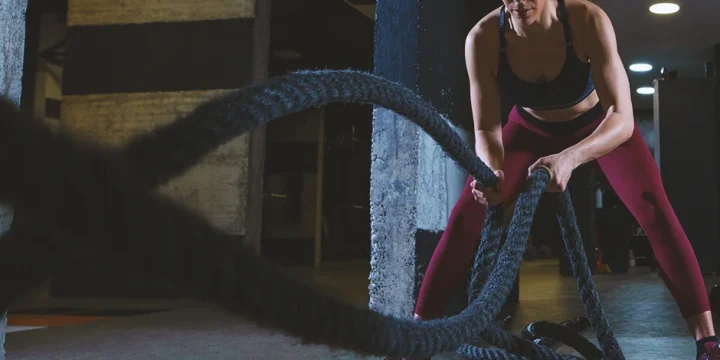Battle ropes are excellent fitness equipment for intensive workouts and great for targeting the whole body.
Having more than 10 years of experience in fitness and conditioning, I singled out the 5 best battle rope exercises for building muscle and burning fat. I tested them all to ensure their effectiveness in a single workout program.
After reading this article, you will get tips for battle rope exercises and learn their most important benefits.
Quick Summary
- Some of the best battle rope exercises and workouts for burning fat include bilateral waves, rope slams, and alternating wide circles.
- Alternative waves, as a type of battle rope exercise, effectively engage your core and provide highly efficient aerobic and anaerobic conditioning.
- Research from the Functional Training Institute shows that regular battle rope training improves grip strength, activates the aerobic energy system, and enhances overall metabolic conditioning in the general population.
- As a fitness trainer, I always emphasize the importance of breathing while working with battle ropes because it really helps build up lactates in your system.
4 Battle Rope Exercises

Below, you will find four battle rope training exercises that my team and I have previously tested. These exercises are designed to enhance your physique, increase lean muscle mass, and promote fat burning.
1. Bilateral Waves
Bilateral waves are vital for effective battle rope workouts, engaging muscles like the erector spinae, latissimus dorsi, and triceps.
How to perform:
- Stand with your feet shoulder-width apart, holding one rope in each hand with a bit of slack.
- Keep your shoulders back, slightly bend your knees, and engage your core.
- Swing both ropes simultaneously below shoulder height and then in the opposite direction, creating a wave-like motion.
- Repeat this movement for the desired duration.
- Beginners can begin with 15-20 seconds and rest for 45 seconds between sets.
2. Unilateral Waves
Unilateral waves, an alternate version of bilateral waves, target the same muscles but require additional core activation, particularly obliquus internus and obliquus externus.
How to perform:
- Stand with your feet shoulder-width apart, holding one rope in each hand with some slack.
- Bend your knees slightly, straighten your back, and engage your core.
- Swing one rope up with your right hand while simultaneously pulling up your left hand in an alternating pattern.
- Beginners can initiate with 2-3 sets of 20 seconds, followed by up to 1 minute of rest for complete recovery.
3. Rope Slams

A challenging variation of bilateral waves, rope slams target your back muscles, particularly the erector spinae and hamstrings, demanding constant hip flexion.
How to perform:
- Stand with feet hip-width apart, holding a rope in each hand with some slack.
- Bend your knees, straighten your back, and engage your core.
- Push the balls of your feet, extending your legs as you lift the ropes over your shoulders.
- Forcefully slam the ropes down, then reverse the movement, bringing them over your shoulder.
- Repeat for the desired time (e.g., 15 seconds) and rest for full recovery.
Also Read: Best Weighted Jump Ropes
4. Alternating Wide Circles
A challenging battle rope exercise for the shoulders, alternating wide circles engage the anterior deltoid, lateral deltoid, posterior deltoid, triceps, latissimus dorsi, and more.
How to perform:
- Stand with feet hip-width apart, holding a rope in each hand with some slack.
- Slightly bend your knees, straighten your back, and engage your core.
- Begin by swinging the rope with your right hand in a circular motion.
- After the rope returns to the starting position, repeat the movement with your opposite hand.
- Continue alternating for up to 20 seconds, then rest for full recovery.
Tips for Effective Battle Rope Workouts

Here are essential tips for maximizing your battle rope workout:
- Vary your movements: Add versatility to your battle rope exercises for better results. Focus on different variations in each workout session.
- Adjust rope length: Increase the rope length to intensify the challenge. Greater rope length provides more leverage, making the movements harder. Consider using a thicker battle rope for added resistance.
- Use as a finisher: Implement battle rope exercises as effective finishers to push your limits and ensure a complete workout.
- Engage your core: Activate your core during battle rope exercises for improved abdominal muscle development. Experiment with half kneeling position variations along with standing exercises to target your core.
- Remember to breathe: Inhale and exhale regularly during battle rope exercises. Avoid holding your breath as it can trigger the lactate mechanism, providing energy in the absence of oxygen.
As a fitness trainer, I advise integrating these tips into your routine to maximize the impact of battle rope exercises in your workout plan.
What Are the Benefits of Battle Rope Exercises?

Battle rope exercises offer dual benefits by engaging both your aerobic and anaerobic energy systems while promoting improved core development and conditioning.
Research from PubMed supports the idea that a battle rope workout enhances cardiorespiratory function [1].
As a fitness trainer, this workout helps improve the ability to keep going during intense activities like combat sports, especially when using your upper body a lot, according to research from PubMed [2].
"The biggest benefit of battle ropes is that they work your entire body. While you may think of them as a predominantly upper body workout, they can also work your lower body and core if you use them effectively."
- Jacob Wymer, a Powerlifting Coach, and Ph.D. Student of MSc Sport Biomechanics
FAQs
How Long Should a Battle Rope Workout Be?
How long a battle rope workout should be will depend on your fitness level. However, beginners should start with 15-second bouts and rest between the sets for over 45 seconds.
Is It Ok to Do Battle Ropes Every day?
Yes, it is ok to do battle ropes every day. However, there is a high chance of overdoing battle ropes and overtraining your body which is bad for your musculature since it won’t have enough time to recover.
Is Battle Ropes a Full-Body Workout?
Yes, battle ropes is a full-body workout. Battle ropes will activate your upper body, lower body, and core musculature for a total body workout.
References:
- https://pubmed.ncbi.nlm.nih.gov/29847529/
- https://pubmed.ncbi.nlm.nih.gov/32091465/
About The Author
You May Also Like






